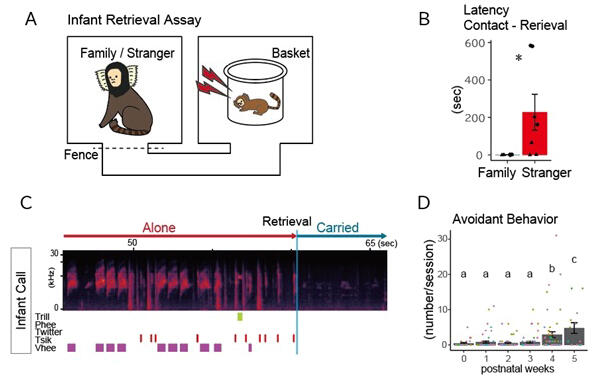Attachment pattern formation in infancy forms the basis of emotional and social development, and it plays an important role in mental health and interpersonal relationships in adulthood. Failure to form sufficient attachments during infancy leads to attachment disorders that cause difficulties in emotional development and relationships with surrounding people. It is currently not fully understood what changes may occur in the brain in relation to this.
The international collaborative research group of Professor Kumi Kuroda of the School of Life Science and Technology at Tokyo Institute of Technology, Assistant Professor Saori Yano-Nashimoto of Hokkaido University, Research Fellow Anna Truzzi of Trinity College Dublin, and Researcher Kazutaka Shinozuka (RIKEN at the time of research) found that the offspring of a common marmoset (a small monkey) acquire the ability to be independent when raised within their families, but when they are prevented from communicating with their families, they develop separation anxiety, just like humans. Marmosets can be used as an excellent model relating to human child-rearing and attachment. In the future, such a model is expected to contribute to clarifying the mechanism behind attachment formation, as well as to understanding and providing assistance in dealing with social problems (attachment disorders) caused by poor environmental conditions and abuse during childhood. The results were published in Communications Biology.

(A) Schematic of the infant retrieval assay in the home cage. A caregiver was placed in one cage, and an infant in a wire basket was placed in an adjacent cage connected via a tunnel with a fence shutter. After the fence was removed, the behavior of the caregiver and infant was observed.
(B) Infants instantaneously clung selectively to their family members but not to the unfamiliar caregivers.
(C) The spectrogram of infant calls (upper) and the classification of the calls (below). Infants call when they are alone, and they stop calling immediately after the retrieval.
(D) Infants within postnatal weeks 0-3 continuously cling to their caregivers and rarely show avoidant behavior (refusal of clinging during contact with their caregivers and voluntary dismounting).
Provided by Hokkaido University
In 2022, Kuroda and her colleagues closely observed the rearing of marmoset families and determined that such child-rearing behavior was characterized by "speed of responding to infant cries (sensitivity)" and "caring for infants without rejection (tolerance)," and they identified the brain region in the forebrain responsible for tolerance. On this occasion, they focused on attachment behavior between infants and family members, an under-researched aspect of the parent−child relationship and investigated the relationship between parenting behaviors and attachment patterns among marmosets.
When an infant marmoset clings to a family member, it feels safe and immediately stops calling. Until three weeks of age, infants have difficulty moving on their own, and they are almost always carried on the backs of family members. It is rare for them to get off the backs or to refuse to be kept on the backs of family members. In several marmoset families, however, some infants avoided being carried, or they cried frequently with anxiety, even when on the backs of family members. An investigation discovered that the family members often ignored the infant's calling or rejected the infant on their backs by biting or rubbing the infant against the wall or floor. In other words, the infants tend to seek out family members who can help them when they are in trouble (with high sensitivity) and make them feel secure when they are on the backs of the family members who are patient toward them (tolerance). Furthermore, the attachment pattern of infants to the same family member was similar, indicating that the infants flexibly changed their behavior depending on the individual family member.
The group then investigated the attachment behavior of the infants who were isolated from the marmoset family (artificially reared infant) for unavoidable reasons such as the need to care for multiple infants or family problems. As a result, unlike infants nursed in families (parent-nursed infants), the artificially reared infants failed to flexibly adapt to the attachment behavior. When the isolated infants were returned to the original family cage, the family members tried to help and carry on their backs the parent-fed and artificially reared infants equally. However, the artificially reared individuals avoided being carried on the backs of tolerant and sensitive family members and quickly left family members following the slightest rejection. They had spent a long time alone. Furthermore, it became clear that the artificially reared infants exhibited a contradictory attachment pattern by continuing to call alone and avoiding other members at the same time. This pattern is similar to "disorganized/confused pattern" that tends to appear in human children who have been abused or neglected.
The present study reveals many similarities between humans and marmosets in their attachment behaviors. With the marmoset as a model animal, the investigators hope to conduct research on the brain parts that control the attachment behavior in infants, in order to clarify the mechanism of human attachment formation as well as to understand and address human attachment disorders.
Journal Information
Publication: Communications Biology
Title: Anxious about rejection, avoidant of neglect: Infant marmosets tune their attachment based on individual caregiver's parenting style
DOI: 10.1038/s42003-024-05875-6
This article has been translated by JST with permission from The Science News Ltd. (https://sci-news.co.jp/). Unauthorized reproduction of the article and photographs is prohibited.




